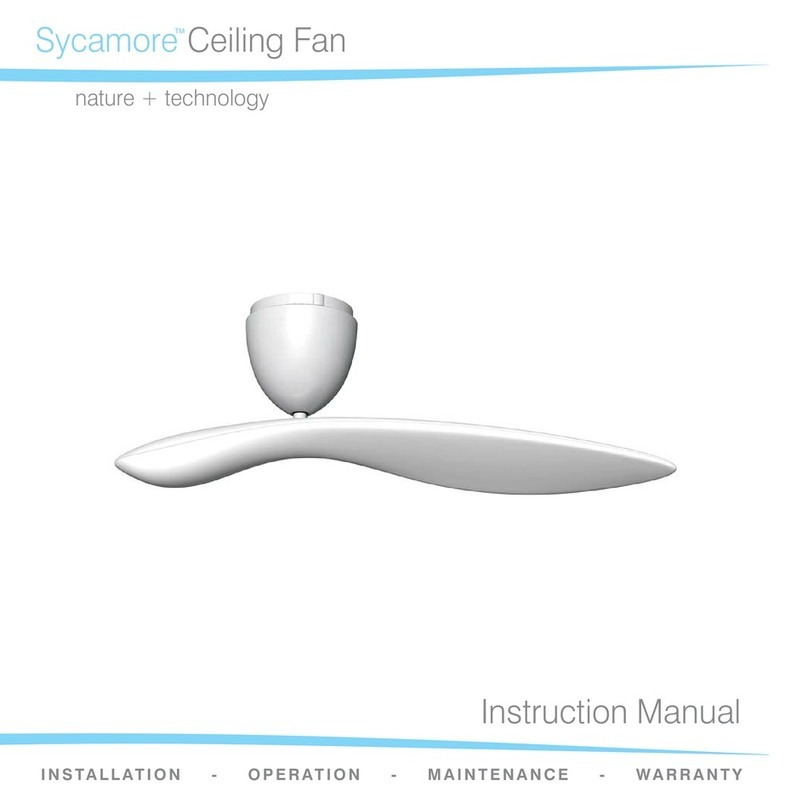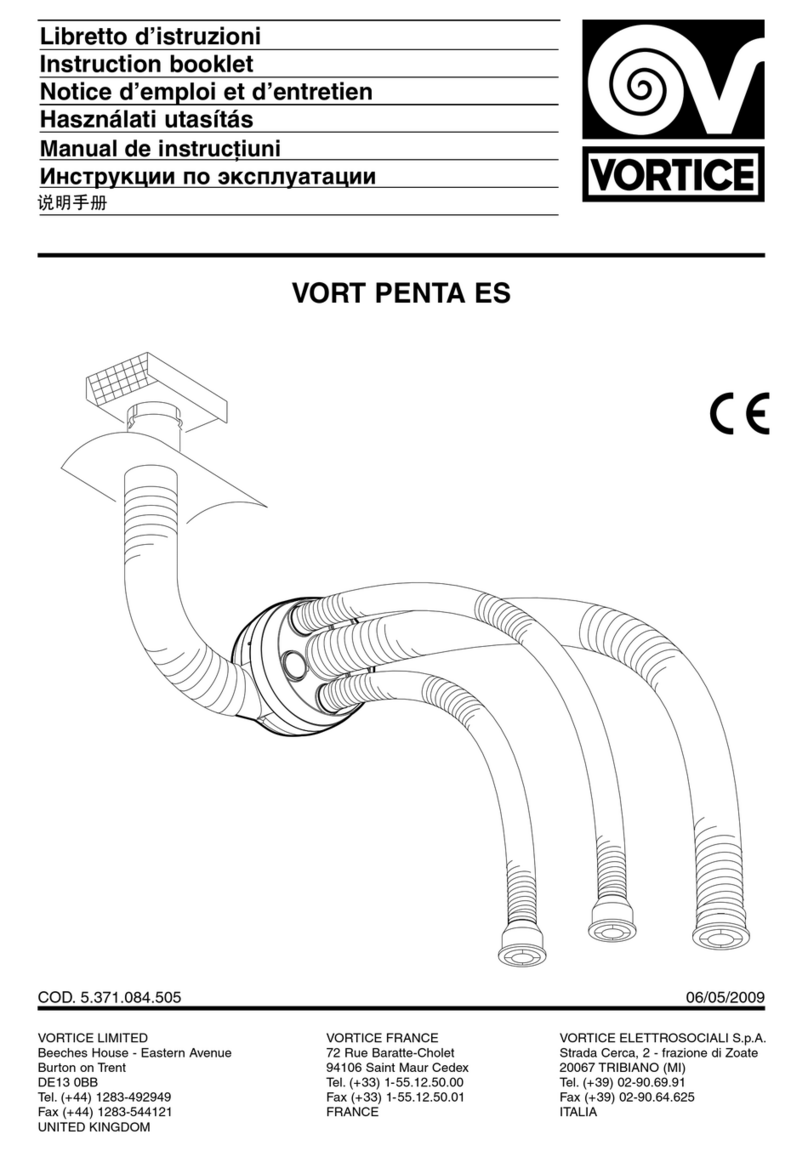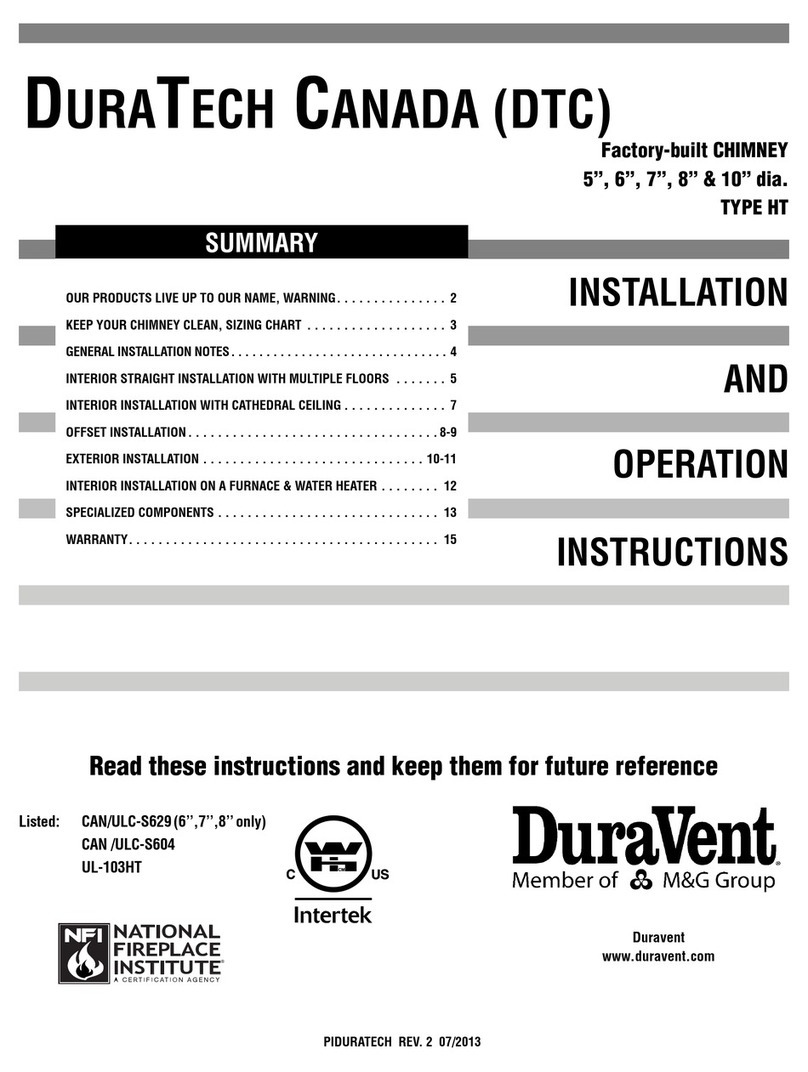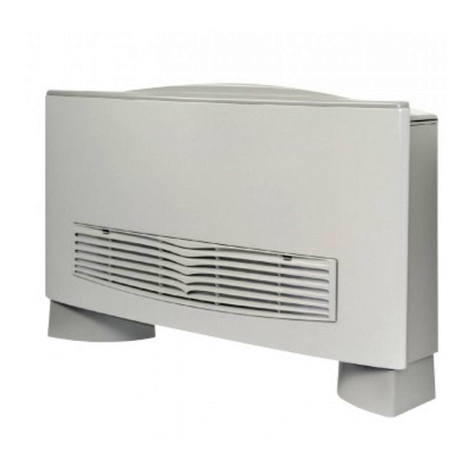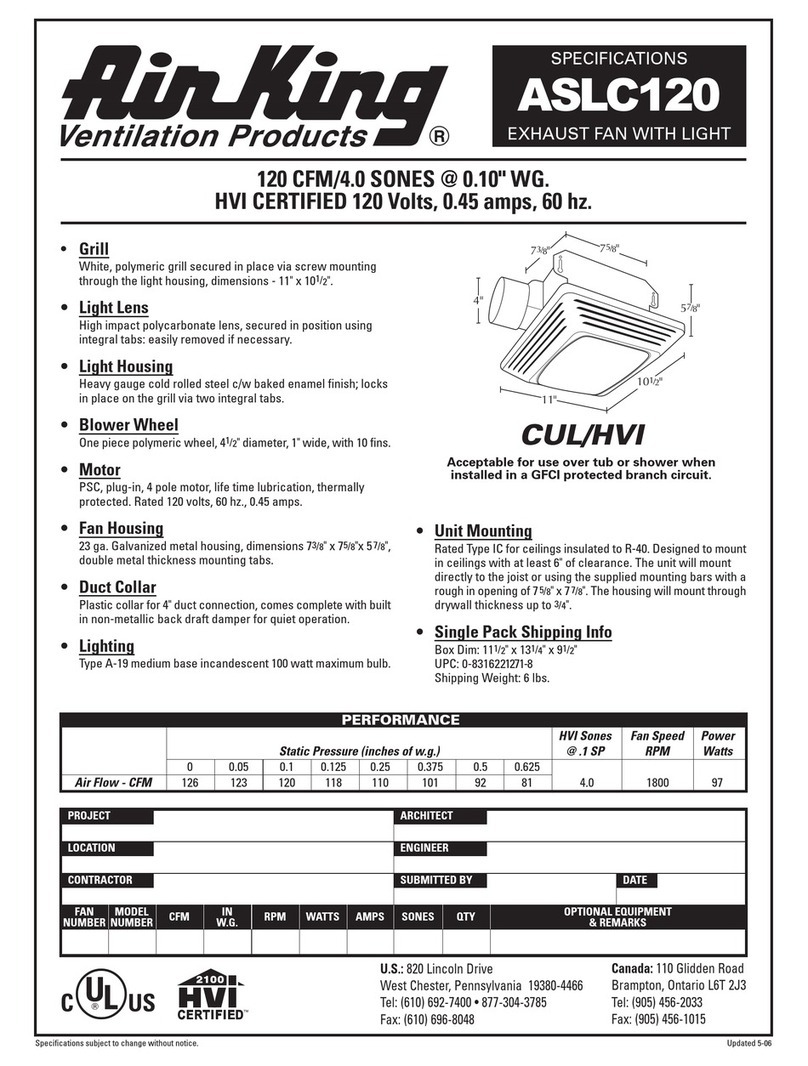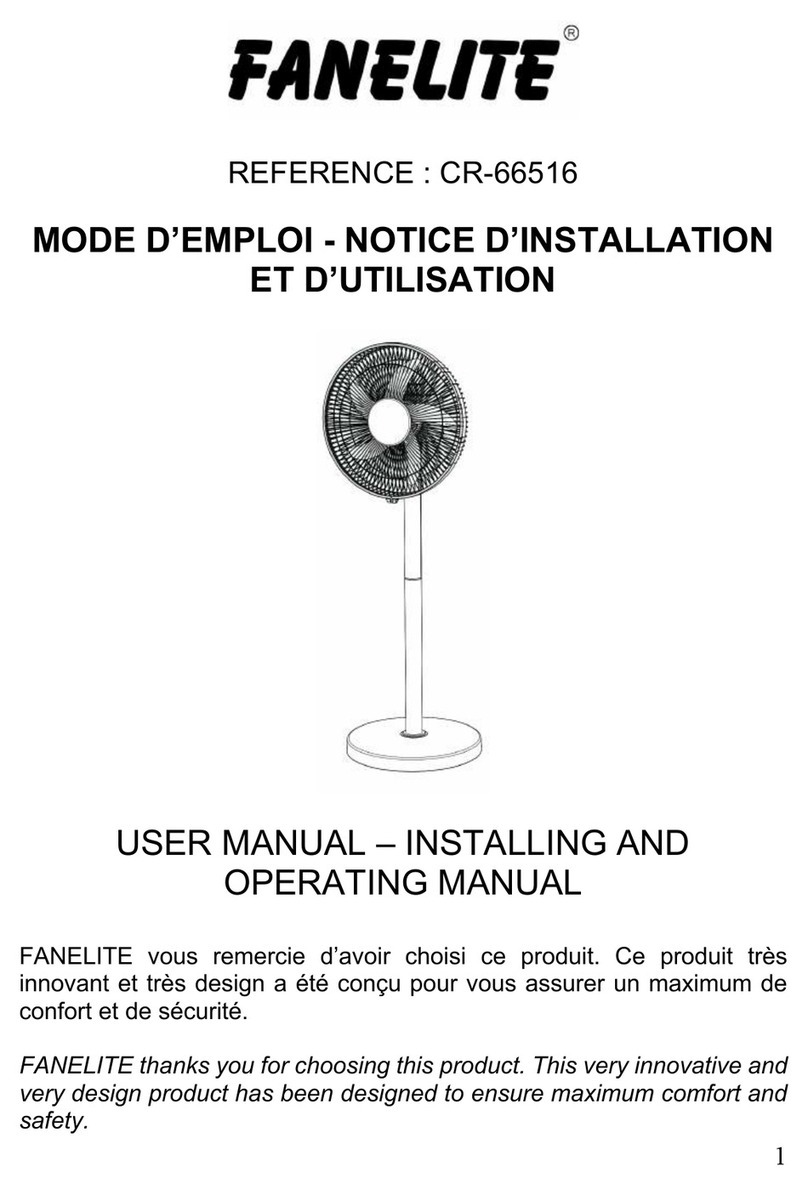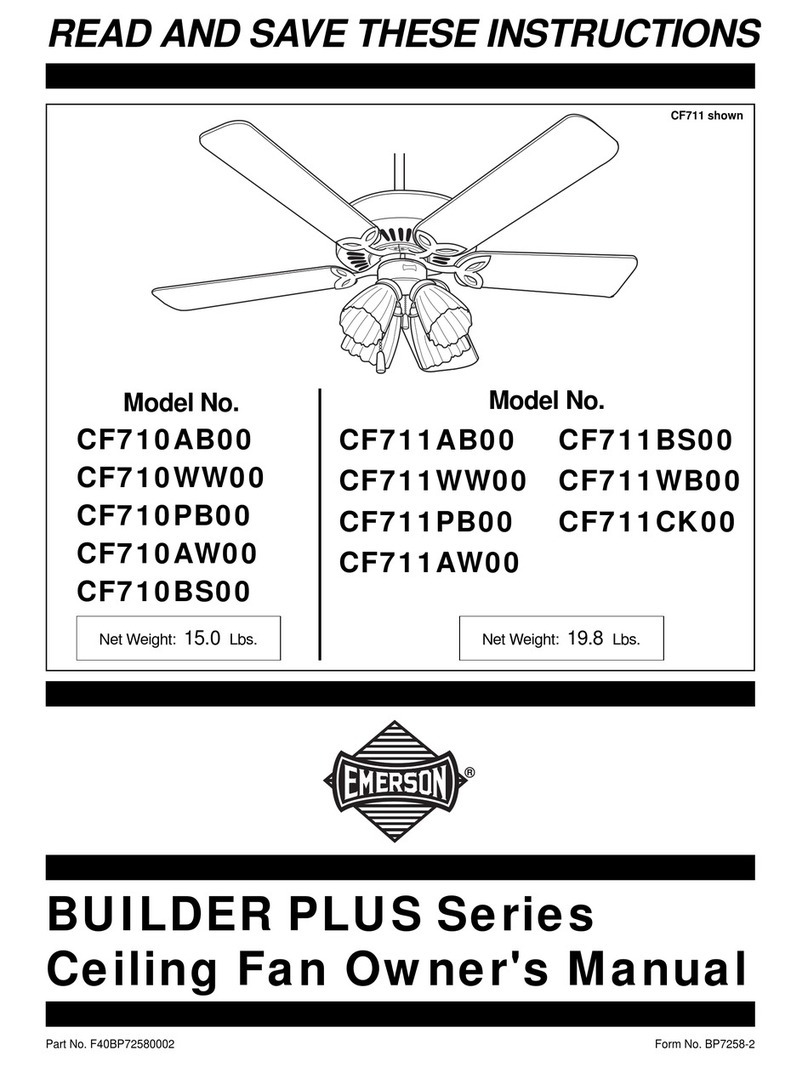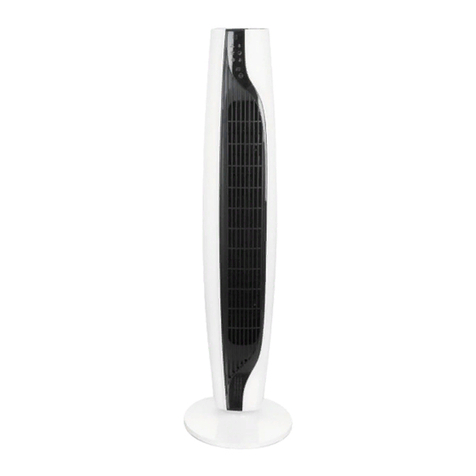NORDICCO NORTHERN LIGHT HVLS User manual

1
STANDARD INSTALLATION MANUAL
NORDICCO®NORTHERN LIGHT HVLS
ENGLISH
Vers. 1.0
IMPORTANT
This system is equipped with UV-lamps and if not used and installed
correctly it can be harmful to people and animals.
Installation and calibration of the Northern Light systems is to be
done by professional and trained installers only. Calibration and in-
spection of the installed systems is recommended every 6 months as
a minimum.
NEVER LOOK DIRECTLY INTO THE LUMINAIRES.

2
before you begin
IT IS THE SOLE RESPONSIBILITY OF THE OWNER AND THE OPERATOR
OF THE INSTALLED NORDICCO NORTHERN LIGHT FANS, TO ENSURE
THAT IRRADIATION LEVELS ARE BEING RE-ASSESSED WHENEVER
CHANGES ARE BEING MADE TO THE CEILING AND SURROUNDINGS,
INCLUDING BUT NOT LIMITED TO UPGRADE OR INSTALLATION OF
NEW CEILING ATTACHED LIGHTS, AND/OR IF THE NORTHERN LIGHT
FANS ARE RELOCATED.
IT IS THE SOLE RESPONSIBILITY OF THE INSTALLER TO ENSURE THAT
PERSONS WILL NOT BE EXPOSED TO EXCESSIVE UVC RADIATION
DURING THE NORMAL OPERATION OF THE INSTALLED SYSTEMS.
ONLY TRAINED INSTALLERS WITH THE NECESSAARY EQUIPMENT
AND KNOWLEDGE OF UVC IRRADITION IS ALLOWED TO UNDERTAKE
THE IRRADIATION ASSESMENT.
THE PURPOSE OF THIS INSTALLATION AND COMISSIONING MANUAL
IS TO ENSURE, THAT THE NORDICCO NORTHERN LIGHT HVLS FANS
ARE CORRECTLY INSTALLED, AND THAT THE UVC IRRADITION LEVEL
IS CORRECTLY CALIBRATED AND BELOW ALL LEVELS ALLOWED BY
LOCAL LAWS AND GUIDELINES PRIOR TO HUMAN OCCUPANCY.
IT IS CRITICALLY IMPORTANT TO READ AND UNDERSTAND THIS ENTIRE
MANUAL BEFORE ATTEMPTING TO INSTALL AND/OR COMISSION THE
NORDICCO NORTHERN LIGHT HVLS FANS. FAILURE TO DO SO MAY RE-
SULT IN DAMAGE OR INJURY.
PRIOR TO INSTALLATION PLEASE ENSURE YOU UNDERSTAND ALL
LOCAL REGULATIONS AND RESTRICTIONS RELATED TO INSTALLING
EQUIPMENT WITH OPTICAL IRRADIATION. SPECIFICALLY THE EURO-
PEAN PARLIAMENT DIRECTIVE #2006/25 OF APRIL 2006, AVAILABLE
ON THE BELOW LINK
https://eur-lex.europa.eu/LexUriServ/LexUriServ.do?uri=O-
J:L:2006:114:0038:0059:DA:PDF

3
Contents
General Safety Information, Pre-installation checks ....................................................................... 4
Precautions & Best Practice in relation to fire ................................................................................ 6
What’s in the Box?........................................................................................................................... 8
Required Tools & Accessories, Standard Mounting...................................................................... 10
Standard Installation Process ........................................................................................................ 11
Mounting & Securing Safety Wire................................................................................................. 12
Mounting the Air Blades ............................................................................................................... 13
Fire Alarm Relay installation.......................................................................................................... 14
Connecting Power & Controller.................................................................................................... 15
Assement of UVC-irradiation......................................................................................................... 16
Technical Specifications..................................................................................................................17
Electrical Diagram......................................................................................................................... 18
Declaration of Conformity................................................................................................ ............ 19
Other manuals, such as Advanced User Guides for setting
up fan networking mode and integrating fans to a building
management system - as well as manuals in other languages
can be downloaded from our website: www.nordicco.eu/
downloads
THIS MANUAL MUST BE KEPT IN A PLACE, WHERE IT IS EASILY
ACCESSIBLE FOR INSTALLERS AND OTHER PEOPLE THAT MAY
HAVE A NEED TO KNOW.

4
To reduce the risk of fire, electric shock, or injury to persons, observe the following:
1. Use this unit only in the manner intended by the manufacturer. If you have questions, contact
NORDICCO or its representative.
2. Before servicing or cleaning the unit, switch power off at service panel and lock the service
disconnecting means to prevent power from being switched on accidentally.
3. Installation work and electrical wiring must be done by qualified person(s) only in accordance
with all applicable codes and standards.
4. DO NOT ALLOW WATER OR SOLVENTS TO ENTER THE MOTOR, THE DRIVE OR AIR-
BLADES. UNDER NO CIRCUMSTANCES SHOULD MOTORS, DRIVE OR AIRBLADES BE
SPRAYED WITH STEAM, WATER OR SOLVENTS.
5. Depending on local requirements an emergency disconnect switch is to be installed between each
NORDICCO fans and the electrical mains. Ensure that such a switch is NOT located directly above
the air blades, so that it can be accessed at all times - regardsless of local requirements it is always
recommended to install an emergency disconnect switch.
General Safety Information
WARNING
IT IS THE SOLE RESPONSIBILITY OF THE INSTALLER TO ENSURE
THAT PERSONS WILL NOT BE EXPOSED TO EXCESSIVE UVC RA-
DIATION DURING THE NORMAL OPERATION OF THE INSTALLED
SYSTEMS. ONLY TRAINED INSTALLERS WITH THE NECESSARY
EQUIPMENT AND KNOWLEDGE OF UVC IRRADITION IS ALLOW-
ED TO UNDERTAKE THE IRRADIATION ASSESSMENT.
TO AVOID THE RISK OF EXCESSIVE UVC IRRADIATION, MAKE
SURE THE SYSTEM IS ALWAYS POWERED OFF AND SECURED
WHEN WORKING NEAR OR ABOVE THE FAN AND AIRBLADES.
IMPORTANT: CONSULT WITH ALL APPLICABLE RULES AND CODES
TO ENSURE THAT ALL NECESSARY REQUIREMENTS ARE MET. IT IS
THE SOLE RESPONSIBILITY OF THE INSTALLER TO ENSURE COM-
PLIANCE WITH APPLICABLE CODES AND STANDARDS.
IT IS THE SOLE RESPPONSIBILITY OF THE OWNER AND THE
OPERATOR OF THE INSTALLED NORDICCO NORTHERN LIGHT
FANS, TO ENSURE THAT IRRADIATION LEVELS ARE BEING RE-AS-
SESSED WHENEVER CHANGES ARE BEING MADE TO THE CEIL-
ING, INCLUDING BUT NOT LIMITED TO UPGRADE OR INSTALLA-
TION OF NEW CEILING ATTACHED LIGHTS, AND/OR WHEN THE
NORTHERN LIGHT FANS ARE BEING RELOCATED.

5
1. Verify that the fan is to be installed in a location where the airblades will be a minimum of 3,0 me-
ters above the finished floor with a safe distance to any obstructions.
2. If the building has a mezzanine or other elevated spaces that may be occupied by people, verify
that no component of the fan can be reached from the highest level or deck. The fan must be po-
sitioned so that the tips of the airblades are a minimum of 1,2 meter away from the furthest point
that a person could extend an appendage outward.
3. CHECK THAT NO HUMAN OCCUPYING THE ROOM WILL HAVE DIRECT LINE OF SIGTH TO
THE UVC LUMINAIRES.
4. Check that the fan will not be mounted in a location near overhead doors or other building open-
ings where gusts of wind may occur. Fans should not be installed or operated in locations where
wind is present.
5. If the building is equipped with a fire sprinkler system, verify that the placement of the fan will not
interfere with correct sprinkler operation and that the fan installation complies with all building
codes.
6. Check to see if the intended placement of the fan is directly below any building lights or skylights.
If possible, avoid installing fans directly below a light source to prevent a strobing effect that can
be caused by fan rotation.
7. For best performance, the fan must be installed with a two-fan diameter minimum clearance to
radiant heaters and HVAC system discharges or intakes.
8. BEFORE INSTALLATION, IT IS IMPORTANT TO VERIFY THE MOUNTING SURFACE WILL
BEAR THE OPERATING WEIGHT AND MAXIMUM TORQUE (TWISTING FORCE) OF THE
TO-BE-INSTALLED NORDICCO SYSTEM. IT IS THE SOLE RESPONSIBILITY OF THE INSTALL-
ER TO ENSURE THAT THE MOUNTING STRUCTURE AND FAN INSTALLATION METHOD
ARE ADEQUATE FOR SAFE OPERATION OF THE NORDICCO FAN.
MAX TORQUE PER NORDICCO FAN SIZE
Fan size (meter) 2,0 3,0 4,0 5,0
Max. torque (Nm) 9,0 28 45 64
9. THE FIXING MEANS FOR THE ATTACHMENT TO THE CEILING SHALL BE FIXED WITH A SUF-
FICIENT STRENGTH TO WITHSTAND FOUR (4) TIMES THE WEIGHT AND TORQUE OF THE
SPECIFIC NORDICCO CEILING FAN (SEE ALSO TABLE BELOW AND ABOVE).
NORDICCO SYSTEM 2,0M 3,0M 4,0M 5,0M
HANGING WEIGHT 34kg 40kg 47kg 55kg
10. To reduce the risk of excessive reflective irradiation ensure that no highly reflective surfaces
are located in the proximity above the airblades. This includes as an example, aluminum
reflective lamps, polished steel surfaces, etc. A full irradiation survey is always required prior
to comissioning the system.
11. Inspect the air blade packaging prior to handling the air blades to ensure that all UVC lumi-
naires are intact. If there is a risk or suspicion that a luminaire has been broken or otherwise
damaged, the luminaires have to be inspected while wearing gloves and proper ventilation
until it has been confirmed that no damage has occured.
12. INSTALLATION AND MAINTENANCE ARE TO BE PERFORMED BY QUALIFIED PERSON-
NEL ONLY, FAMILIAR WITH LOCAL REGULATIONS AND EXPERIENCED WITH THIS TYPE
OF EQUIPMENT.
Pre-installation checks

6
PRECAUTIONS & BEST PRACTICE
Since the installation and use of HVLS fans are not regulated by any official legislation or building
regulations in relation to fire protection in Denmark, NORDICCO and DBI (The Danish Institute
of Fire and Security Technology) have prepared this guide to ensure optimal installation of NOR-
DICCO HVLS fans. It is DBI's assessment that NORDICCO HVLS fans can be installed while main-
taining fire safety. However, it should be noted that the smaller the rotor diameter of the HVLS
fan, the less the risk of fire spreading. The risk of fire spreading also depends on the location of
the individual HVLS fan. Below are 3 scenarios where it is relevant to assess the detection of an
incipient fire. In case of doubt, a competent advisor should be consulted for an assessment of the
specific situation.
1. The HVLS fans should be installed so that they can easily be disconnected – for example
via a control panel, emergency stop or safety switch mounted visibly at exits or located at
strategic locations in the room.
2. A vertical respecting distance of at least 0,5 meters from combustible storage to the HVLS
fans should be kept to ensure that any fire spread is reduced.
3. HVLS fans should be installed as far from storage (e.g. storage racks) as possible. When
installing in warehousing, fans should be installed above walking areas and not over stora
ge racks.
Scenario 2: NORDICCO HVLS fans installed in a room, where an Automatic Fire Alarm
system is installed. In addition to DBI’s normal guidelines for Automatic Fire Alarm systems, the
following points are also relevant:
1. The HVLS fan must stop when the Automatic Fire Alarm system detects a fire and prefe
rably before this time. This can be done via the built-in "fire alarm cable", or via the manu
al stop options as indicated in scenario 1.
2. For systems with flame detectors, the location of the HVLS fans should be assessed in rela
tion to the location of flame detectors. There are examples of ceiling fans causing reflecti
ons that are mistaken for light from a flame, thereby giving an unintended alarm. Flame
detectors are typically used in rooms with high ceilings and in atriums.
3. Do not install the HVLS fans in the sightlines of any line smoke detector, as this may cause
false alarms from the Automatic Fire Alarm system. A line smoke detector uses ultraviolet
and infrared light that is not visible. The light is either received or reflected on an oppo
sing wall. If the light beam is interrupted, the Alarm system goes into error mode.
4. If spot smoke detectors are installed, a number of considerations must be taken into ac-
count:
a) The velocity of the airflow from the HVLS fan must not exceed 0,5 m/sec. This value
corresponds to the value in DBI Guideline 232 for airflows from ventilation systems.
b) A respecting distance of at least 0,5 meters from spot smoke detectors to the air bla
des of the HVLS fan must be kept.
IN RELATION TO FIRE AND FIRE HAZARDS
Scenario 1: NORDICCO HVLS fans installed in a room without any fire protection systems.
As a general rule, HVLS fans can be installed without any restrictions, but the following
points should be considered:
PRECAUTIONS & BEST PRACTICE

7
If there is doubt about the placement of an HVLS fan in a room where an Automatic Fire Alarm sy-
stem is installed, an approved installation company should evaluate the specific case. The instal-
lation company must be approved to project according to the guidelines according to which the
current Automatic Fire Alarm system is installed.
1. The maximum diameter of the HVLS fan should not exceed 8 meters.
2. HVLS fans should be placed in the center of 4 sprinkler heads.
3. The distance between the HVLS fans and sprinkler heads should be at least 0,9 meters, so
as not to interfere with the activation of the sprinkler system.
4. HVLS fans should be connected to the Automatic Fire Alarm system (if installed) and the
sprinkler system’s control equipment, so that the HVLS fans stop when a fire is detected.
In case of doubt about the placement of HVLS fans in spaces where a Fire Sprinkler system is
installed, an approved installation company should evaluate the specific case. The installation
company must be approved to project according to the guidelines according to which the current
Fire Sprinkler system is installed.
Scenario 3: NORDICCO HVLS fans installed in a room where a Fire Sprinkler system is in-
stalled. HVLS fans can be installed in such rooms, but it must be taken into account that the
Fire Sprinkler system must be able to be activated by a fire in the room. The points in scenario 1
should be considered - and in addition, the following points are also relevant and recommended
by the NFPA (National Fire Protection Association):

8
1
2
3
4
5
6
7
8
9
10
11
11
12
13
14
15
16
12
10
8
7
6
4
3
2
Swivel Mount
Drop Tube
Drive and Onboard Electronics
Motor
Controller (if ordered)
Starfish Blade Hub
1,5m Patch Cable with RJ45 Plug
3m (3 x 1,5 mm2) 230V power cable
Fire alarm cable
Mount Cover (if ordered)
Safety Wire
Safetywire Lock (Gripple)
2 x Extension Tubes
2 x Alu Extension Connectors
Required screws and bolts
Bottomcover
UVC-irradiation dampers
15
SCREWS FOR CONCRETE
MOUNTING
4 pcs. HUS3-H 6x80 mm.
DRILL BIT 6MM HSS
SCREWS FOR WOOD
MOUNTING
4 pcs. 8x70 mm.
DRILL BIT 5MM
BOLTS FOR STEEL
MOUNTING
4 pcs. 8x25 mm.
4 washers, 4 locknuts
DRILL BIT 8.5MM HSS
DROP TUBE & EXTENSION
TUBE BOLTS
10 pcs. 10x70 mm., 10 locknuts
20 pcs. plast cap (attach to both ends)
NO DRILL BIT NEEDED
1
9
BOX 1
13
14
5
16
10
17
what’s in the box?

9
1
2
21
SCREWS FOR MOUNTING AIR
BLADES
10 pcs. 6x16 mm.
10 lock washers
NO DRILL BIT NEEDED
Anodized Aluminum
Air Blades with UVC
system
Required screws
and bolts
BOX 2 BOX 1
UVC-irradiation
dampers
17
Reduction percentage with different dampers
95% 90% 80% 60% 40%

10
required Tools & accessories
10,13 & 17 MM
WRENCH
LEVEL DRILL PHILLIPS
SCREWDRIVER
SLOTTED
SCREWDRIVER
SOCKET
WRENCH
3 X 1,5MM 230V
POWER CABLE
PATCH CABLE
LIFT OR
SCAFFOLDING
STANDARD MOunting
4 & 14 MM
ALLEN KEY
Using the swivel mount, the NORDICCO FAN SYSTEM can be
mounted directly on to standard I and H steel beams, wood
beams and concrete beams. This is done using relevant bolts
and screws as shown on page 8 and explained on page 11.
For installations using the optional mounting brackets or guy
wires, please refer to the manual: ‘INSTALLATION MANUAL
- EXTRA MOUNTING OPTIONS’ which can also be accessed
from www.nordicco.eu/downloads.
Before performing a standard installation, please check that
the mounting beam has sufficient width to accomodate the
Swivel Mount.
If this is not the case, the extra mounting options can be used,
as explained in the manual: ‘INSTALLATION MANUAL - EXTRA
MOUNTING OPTIONS’.
10,13 & 17 MM
WRENCH SOCKET
SWIVEL MOUNT DIMENSIONS
14,6 cm
10,0 cm
8,0 cm
12,0 cm
Remember to tighten the bolts
after leveling the fan.
SAFETEST UVC

11
Standard Installation process
Attach the fan assembly to the swivel
mount via the drop tube using bolts
specied on page 8 and fasten securely.
Fasten the swivel mount to the mounting
surface using screws (concrete and wood)
or bolts (steel). Tighten thoroughly.
Pull safety wire, power cable, re wire
and Patch cable through designated
hole.
Line up the holes and tighten bolts
thoroughly.
If needed, attach one or two Extension
Tubes to the Drop Tube using the Alu
Extension connectors.
Pull power cord, re cable, safety wire,
Patch cable through the Extension Tube.
Using the swivel mount as a template,
drill required holes in the mounting
beam using the drill bit specied on
page 8.
Secure safety wire around mounting
beam.
IMPORTANT: follow steps on page 12.
Push the mount cover up and twist to
lock in place by the two small screws as
shown above.
7
1
4
2
5
3
NOTE: IF YOU CANNOT INSTALL
DIRECTLY ON THE MOUNTING
SURFACE, YOU CAN USE EXTRA
MOUNTING BRACKETS AS
EXPLAINED IN ‘INSTALLATION
MANUAL - EXTRA MOUNTING
OPTIONS’. AVAILABLE ON
WWW.NORDICCO.EU/DOWN-
LOADS
8
6

12
Mounting & securing safety wire
Insert wire by pushing and twisting
clockwise into
A
Tighten wire. Cut or organize excess wire to ensure it does not interfere with fan performance.
Pull wire through
B
Pull wire around mounting beam,
and insert wire in
C
- follow arrow direction
A
B
C
NOTE: THE SAFETY WIRE MUST BE INSTALLED AS IT PREVENTS THE
NORDICCO HVLS FAN FROM FALLING IN THE UNLIKELY EVENT THAT THE
MOUNTING SYSTEM SHOULD FAIL.
THE FAN SHOULD NEVER BE OPERATED WITHOUT A PROPERLY INSTAL-
LED SAFETY WIRE, AS THIS COULD RESULT IN DEATH, SERIOUS INJURY
OR ASSET DAMAGE. FAILURE TO INSTALL SAFETY WIRE WILL RESULT IN
VOIDING OF THE FAN WARRANTY.

13
Ensure that the system is fully powered
off before proceeding.
Mounting the air blades
Slide air blade onto the starsh hub
(make sure that no wires are damaged
during the installation).
Slide bottom cover into position and
screw in place.
Connect the power plug from the fan to
the socket on the power distributer plate.
Air blade view from above.
Secure air blade using screws and tools
as specied on page 9.
12
CORRECT POSITIONING OF THE SCREWS
NOTE: Before mounting the air blades, ensure the fan is vertically and horizontally level.
IMPORTANT: Do not operate the fan without the air blades mounted, as this may damage the
motor and the motor drive.
CHECK: ROTATE
THE FAN BY HAND
TO ENSURE THAT
IT ROTATES FREELY
AND DOES NOT
COME INTO CON-
TACT WITH ANY
OBSTRUCTIONS.
Air blade view from the side.
2
13
5
3
4
45
Bottomcover from the side.

14
FIRE ALARM RELAY INSTALLATION
OPTIONAL FIRE ALARM RELAY INSTALLATION
Note: This section is only applicable in buildings equipped with a re suppression system. For
buildings without a re suppression system, simply leave the re cable untouched in the droptube.
Important: The re alarm relay should only be installed by qualied personnel familiar with the
operation of building re suppression systems. It is the sole responsibility of the installer to ensure
correct operation of the re alarm relay in the event of re emergency in the building.
Strip the loose wires and wire them to a normally-closed potential free relay on the re alarm
emergency stop landing point and the building’s re suppression system using the wiring diagram
above.
To landingpoint at fan
To re supression system
Pre-wired re alarm
landing point
24 VDC
N.C.
Relay

15
Connecting power & TABLET controller
1
2For setting up tablet
controller, please refer
to tablet guide.
Connect the power plug to the power cable.
Then connect to 230V single phase power supply,
Using extra power cable as needed.
3If you control and monitor the installed NORDICCO HVLS fans with the NORDICCO
Fan Management System, then please refer to the NORDICCO Fan Management
System installation guide available on www.nordicco.eu/downloads.
If you control and monitor the installed NORDICCO HVLS fans using a building ma-
nagement system (CTS), then please refer to the integration to the building manage-
ment system available on www.nordicco.eu/downloads.

16
ASSESSMENT OF UVC-IRRADIATION
Using UVC-irradition measuring tools such as the SAFETEST suggested abo-
ve (available from NORDICCO upon request) the UVC-irradiation levels are
measured in accordance with the equipment providers´ instructions and at
several locations across the specific room. In the event UVC-irradiation levels
are above usage or local requirement, use the supplied "UVC-irradiation
dampers" and install these above the supplied UVC-luminaires in accordan-
ce with the instructions below.
REQUIRED TOOLS & ACCESSORIES
Mechanical UVC-irradiation dampers
SAFETEST UVC
Re-assess UVC-irradtion and continue to follow the process until UVC-irradiation levels are below
local requirements. Only at that stage are people allowed into the room.
It is the sole responsibility of the installer to ensure proper documentation of the irradiation mea-
surement.
Loosen the end piece and replace the
glass with the required UVC-irradiation
damper.
MOUNTING UVC-IRRADIATION DAMPER
Fasten end piece onto the airblade and
screw in place.
2
13
Air blade with UVC-irrradiation damper.
Reduction percentage with different dampers
95% 90% 80% 60% 40%

17
System Diameter Load Level 100% 80% 60% 40%
2,0m
Speed (RPM) 160 128 96 64
m3/hr * 23.400 18.720 14.040 9.360
Input Power (W) 68 41 21 8
3,0m
Speed (RPM) 127 102 76 51
m3/hr * 81.360 65.040 48.780 32.520
Input Power (W) 222 125 59 27
4,0m
Speed (RPM) 73 58 44 29
m3/hr * 115.260 92.220 69.120 46.080
Input Power (W) 185 106 51 22
5,0m
Speed (RPM) 49 39 29 20
m3/hr * 124.500 99.600 74.700 49.800
Input Power (W) 134 74 34 15
* Tested and validated by the Danish Technological Institute
PRODUCT NUMBER NORTHERN LIGHT
200
NORTHERN LIGHT
300
NORTHERN LIGHT
400
NORTHERN LIGHT
500
System Diameter (m) 2,0 3,0 4,0 5,0
Voltage (V) 230 230 230 230
System hanging weight (kg) 34 40 47 55
Effective coverage area (m2) 100 300 400 500
Recommended distance between
systems (m)
6 10 14 18
EN version 1.0
TECHNICAL SPECIFICATIONS

18
ELECTRICAL DIAGRAM
A2-
12
1411
12
1411
L1
PE
L2/N
0-10V LED control 13
24VDC supply 2
Firealarm + 8
Firealarm - 9
GND 1
Modbus data + 10
Modbus data - 11
PE 14
PE 12
PE 3
Thermocouple + 4
Thermocouple - 5
Windsensor + 6
Windsensor - 7
Standard input R = 10k ohms pull up
L1
PE
L2/N
0-10V LED control 13
24VDC supply 2
Firealarm + 8
Firealarm - 9
GND 1
Modbus data + 10
Modbus data - 11
PE 14
PE 12
PE 3
Thermocouple + 4
Thermocouple - 5
Windsensor + 6
Windsensor - 7
Nordicco Northern LightTM
A1+
YR
PEPE PEPE
NN NN
LL LL
Yellow
Black
Red
Brown
Brown
White/brown
Orange
Yellow
Black
Red
Yellow/green
Blue
Red
3 -PE3 -PE
2 - N
2 -N
1 - L
1 -L
1
1
2
2
3
3
4
4
1
2
3
4
1
2
3
4
N
L L
PE PE
NN
L L
PE PE
N
N
L L
PE PE
NN
L L
PE PE
N
N
L L
PE PE
NN
L L
PE PE
N
N
L L
PE PE
NN
L L
PE PE
N
N
L L
PE PE
NN
L L
PE PE
N
Yellow/green
Blue
Brown
3 -PE3 -PE
2 - N
2 -N
1 - L
1 -L
1
1
2
2
3
3
4
4
1
2
3
4
1
2
3
4
Yellow/green
Blue
Brown
3 -PE3 -PE
2 - N
2 -N
1 - L
1 -L
1
1
2
2
3
3
4
4
1
2
3
4
1
2
3
4
Yellow/green
Blue
Brown
3 -PE3 -PE
2 - N
2 -N
1 - L
1 -L
1
1
2
2
3
3
4
4
1
2
3
4
1
2
3
4
Yellow/green
Blue
Brown
3 -PE3 -PE
2 - N
2 -N
1 - L
1 -L
1
1
2
2
3
3
4
4
1
2
3
4
1
2
3
4
Yellow/green
Blue
Brown
Orange
Orange
Black
Black
Orange
Orange
Black
Black
Orange
Orange
Black
Black
Orange
Orange
Black
Black
Orange
Orange
Black
Black
Slip-Ring
24VDC
0-10VDC
Input
Ballast
Connector
Socket
Airblades
UVC light source
UVC light source
UVC light source
UVC light source
UVC light source

19
DECLARATION OF CONFORMITY
Dennis Thomsen
March 17 2021

20
Address
Nordicco A/S
Karetmagervej 23
7000 Fredericia
Denmark
CONTACT
+45 73 70 90 83
info@nordicco.eu
www.nordicco.eu
NORDICCO A/S
We are a family owned and operated company,
wanting to contribute towards the acceleration to a
more sustainable economy.
We design and manufacture climate-friendly High
Volume Low Speed (HVLS) fan based ventilation
and desinfection systems.
Our solutions help our customers improve
their indoor climate, lower their energy
consumption, reduce their CO2 emissions
and eliminate the spread of airborne pathogens.
We manufacture in Denmark and whenever
possible, we source from local vendors, using
materials with the lowest possible carbon footprint.
CLIMATE-FRIENDLY COMFORT
MADE
IN
Table of contents
Other NORDICCO Fan manuals

NORDICCO
NORDICCO NORTHERN LIGHT User manual

NORDICCO
NORDICCO NORTHERN AIR MINI User manual

NORDICCO
NORDICCO NORTHERN AIR MINI User manual

NORDICCO
NORDICCO NORTHERN LIGHT Guide
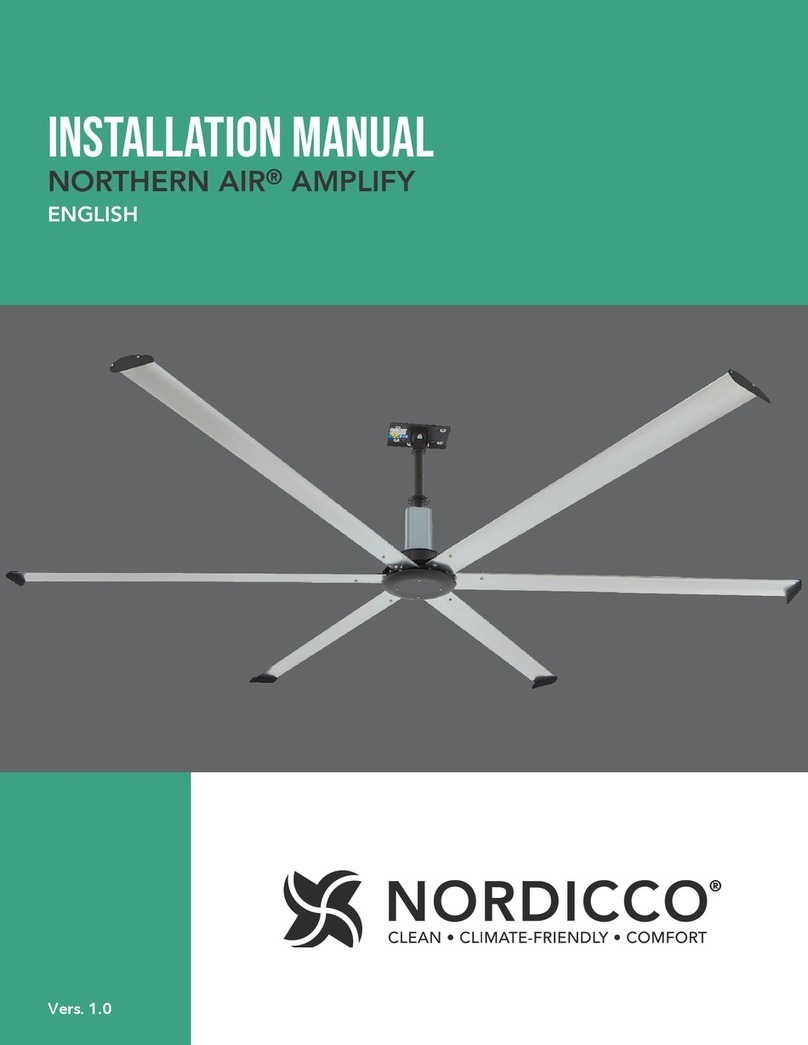
NORDICCO
NORDICCO NORTHERN AIR AMPLIFY User manual

NORDICCO
NORDICCO AIR MINI User manual

NORDICCO
NORDICCO HVLS Guide

NORDICCO
NORDICCO NORTHERN AIR 200 Guide
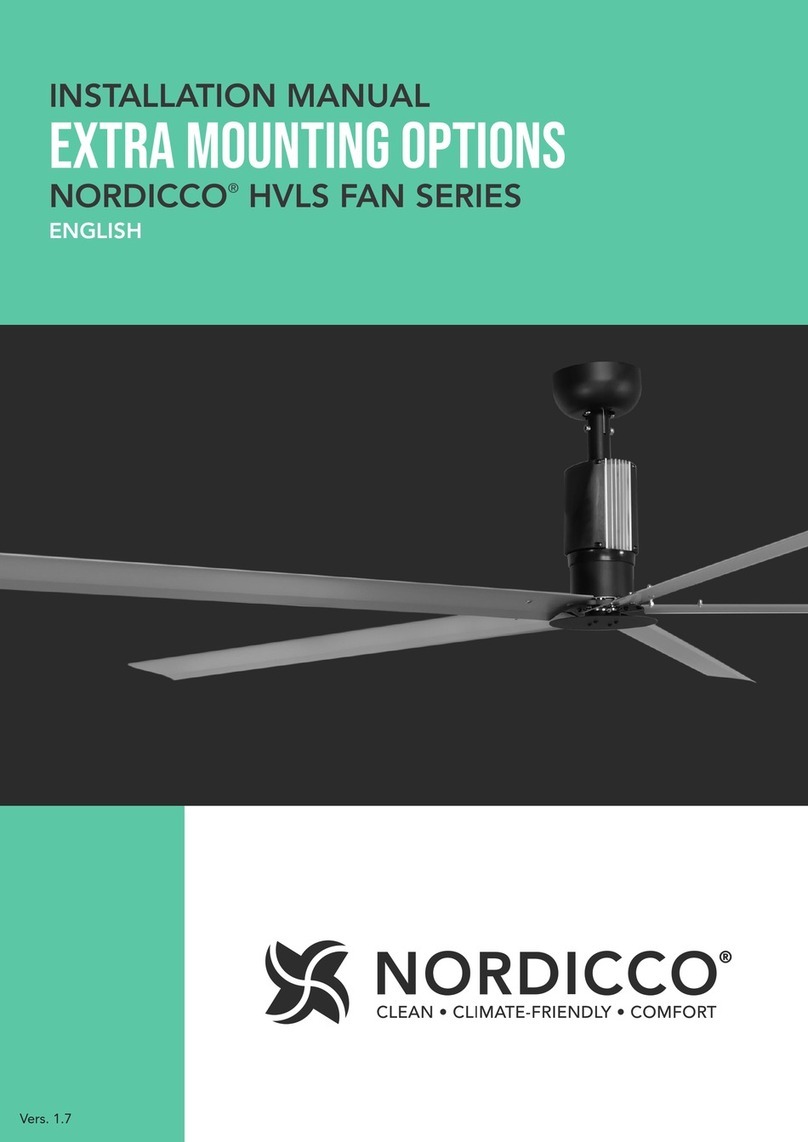
NORDICCO
NORDICCO HVLS Series User manual
